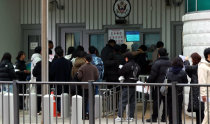Ssangyong Workers Return After 16-month Leave
Ssangyong Workers Return After 16-month Leave
Posted June. 15, 2010 13:40,
Outsiders will not seek to save Ssangyong. Itll be you and me wholl have to save it. Top managers? Will they work for the company as long as you?
Participants nodded Monday at these comments made by Lim Taek-geun, a senior technical worker who is the de facto manager of the management group, at a lecture he gave as an in-house lecturer. He spoke at a lecture hall in the human resources development center of Ssangyong Motor in Anseong, Gyeonggi Province.
In attendance were groups of technical staff clad in uniforms who returned to their jobs after a 16-month leave.
○ Staff return to work after 16 months
Ssangyong suspended work for more than 410 technical and engineering staff in February last year, saying they would return to work around the end of the year and urged patience. The decision was made a month after the automaker was put under court receivership.
The schedule for their return was delayed indefinitely due to a prolonged strike and sluggish sales, however.
Ssangyong has been reborn as a company with friendly labor-management relations after the prolonged strike. It has brought back more than 140 workers, primarily on-site supervisors, and production management positions in phases since October last year as part of efforts to introduce its new model Korando C between July and December this year.
More than 270 employees with 10-20 years of experience in manufacturing vehicles on assembly lines, however, waited for more than a year to return.
One assembly worker said, Wed get together once a month only to hear from management that it couldnt afford to bring us back. We then talked with colleagues over soju (a Korean liquor) and exchanged information on part-time job opportunities.
Most staff members who were on the extended leave used most of their savings and worked part-time jobs to earn a living. A production worker with 15-20 years of experience said, I worked as a day laborer at a water tank cleaning agency through Friday, noting, I doubted whether I could return to the company and worried to death that I might be on the list of employees subject to dismissal.
Staff members on leave were paid a portion of their regular salaries, but even this was often paid late. The amount of back pay owed reached nearly 10 million won (8,500 U.S. dollars) at one point.
The 270 staff members who ended their leave will undergo training on safety and vocational aptitude at the human resources training center Monday to Wednesday. They will then be deployed to an assembly line that produces the Korando C.
The production line will only comprise staff members who have returned to work after a hiatus. They will assemble the new sport utility vehicle, whose success could determine the fate of the automaker.
○ Self-reflection on a bad practice
Staff members at the training session took notes on the lecture, got together with supervisors at break time, and asked questions on newly installed equipment at the assembly line, showing strong enthusiasm.
Park Yeong-tae, the head of the automakers joint management team, gave a briefing on the companys managerial situation.
Sohn Seung-gi, general manager of a production line, urged staffers that quality should be the top priority, showing a changed environment after corporate restructuring.
Calls for self-reflection rang as well. Senior worker Lim said, Frankly, when we had a problem in the production line in the past, did we discuss it with team leaders or with the union?
A person answered, We discussed it with union leaders, to which Lim said, This is a matter that a staff member at the management team would feel uncomfortable commenting on, but Im a technical staff member, and I asked this question to reflect on a wrong practice of the past.
tesomiom@donga.com







